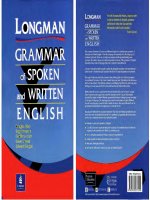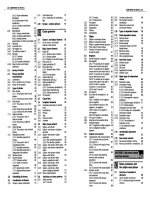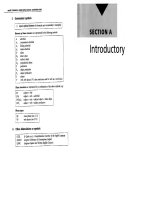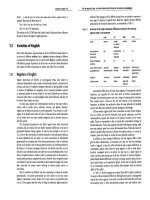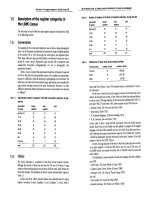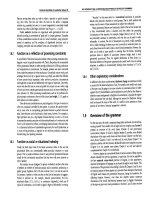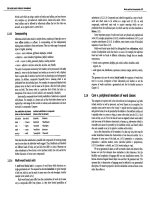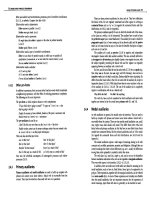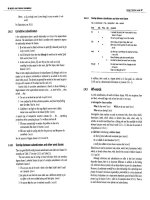Stance in spoken and written university registers
Bạn đang xem bản rút gọn của tài liệu. Xem và tải ngay bản đầy đủ của tài liệu tại đây (861.77 KB, 20 trang )
Journal of English for Academic Purposes
5 (2006) 97–116
www.elsevier.com/locate/jeap
Stance in spoken and written university registers
Douglas Biber *
English Department, Northern Arizona University, Flagstaff, AZ 86011-6032, USA
Abstract
Numerous studies have investigated the linguistic expression of stance and evaluation in university
registers, focusing especially on academic research writing and to a lesser extent classroom teaching. The
present study extends previous research in two ways: (1) it compares and contrasts the use of a wide range
of lexico-grammatical features used for the expression of stance (rather than focusing on a particular
feature), and (2) it describes major patterns of register variation within the university, comparing the
marking of stance in academic versus ‘student management’ registers, within both speech and writing.
The study shows that the expression of stance is important in all university registers. However, at the
same time, the study shows that there are important register differences in the particular kinds of stance
meanings that are expressed, the grammatical devices used to express stance, and in the overall extent to
which stance is expressed at all.
q 2006 Elsevier Ltd. All rights reserved.
Keywords: English for academic purposes; Spoken university registers; Written university registers; Stance; Textbook
language; Corpus linguistics
1. Introduction
Over the last several years, linguists have become increasingly interested in the linguistic
mechanisms used by speakers and writers to convey their personal feelings and assessments.
Such investigations have been carried out under several different labels, including ‘evaluation’
(Hunston, 1994; Hunston & Thompson, 2000), ‘intensity’ (Labov, 1984), ‘affect’ (Ochs, 1989),
‘evidentiality’ (Chafe, 1986; Chafe & Nichols, 1986), ’hedging’ (Holmes, 1988; Hyland,
1996a,b), and ‘stance’ (Barton, 1993; Beach & Anson, 1992; Biber & Finegan 1988, 1989;
Biber, Johansson, Leech, Conrad & Finegan, 1999, Chapter 12; Conrad & Biber, 2000; Precht,
2000). These investigations of personal expression have been conducted with a variety of
* Tel.: C1 928 523 6156; fax: C1 928 523 7074.
E-mail address:
1475-1585/$ - see front matter q 2006 Elsevier Ltd. All rights reserved.
doi:10.1016/j.jeap.2006.05.001
98
D. Biber / Journal of English for Academic Purposes 5 (2006) 97–116
complementary methodologies, ranging from detailed descriptions of a single text sample to
empirical investigations of general patterns in large computer-based corpora.
The expression of evaluation and stance in academic research writing has been an especially
popular area of research (e.g. Charles, 2003; Crompton, 1997; Grabe & Kaplan, 1997;
Hunston, 1994; Hyland, 1994, 1996a,b; Meyer, 1997; Varttala, 2003). Many of these studies
have focused on the use of hedging devices. Hyland (1996a,b) is one of the most important
studies in this area of research, documenting the range of functions and grammatical devices
used to express tentativeness and possibility in academic research articles. For example,
content-oriented hedges have two major functions: indicating the accuracy of a proposition
(e.g. adverbials like generally, approximately, partially, possibly), or limiting the writer’s
commitment to a proposition (e.g. the present work indicates., the model implies.). Hyland
(2002a) extends this line of research by investigating the ways in which authors refer to
themselves (and when they do not refer to themselves) in academic prose. One of the themes
that Hyland has developed over recent years is that academic research articles are interactive,
in that authors actively try to involve the reader in the communication process. Specific studies
in this line of research have investigated the use of addressee features (Hyland, 1999, 2001)
and directives (Hyland, 2002c). Several other studies of academic research articles have
focused on special classes of verbs that function to express evaluation or stance (e.g. Hunston,
1995). For example, Thompson and Ye (1991), Hyland (2002b) describe the use of reporting
verbs (like state, consider, find) and the different kinds of stance meanings expressed by those
verbs (e.g. ‘factive’: acknowledge, identify, prove; ’counter-factive’: confuse, disregard; and
‘non-factive’: claim, propose).
Although most ESP/EAP studies have focused on written academic discourse, more recently
researchers have begun to turn their attention to university classroom discourse, including the study
of stance and evaluation. The MICASE project (Michigan Corpus of Academic Spoken English) has
been one of the most productive efforts to describe spoken university registers. Recent studies in this
line of research include: Poos and Simpson (2002) on the uses of kind of and sort of as hedges;
Lindemann and Mauranen (2001) describing the functions of just for metadiscourse and hedging;
Swales and Burke (2003) on the functions of evaluative adjectives and intensifiers; and Mauranen
(2003) describing the expression of evaluation and other kinds of metadiscourse.
The present study extends previous research in two ways: (1) it compares and contrasts the
use of a wide range of lexico-grammatical features used for the expression of stance (rather than
focusing on a particular feature), and (2) it describes major patterns of register variation within
the university, comparing the marking of stance in academic and ‘student management’
registers, within both speech and writing.
The study adopts the theoretical framework of ‘stance’ developed in the Longman Grammar
of Spoken and Written English (LGSWE) (Biber et al., 1999, Chapter 12). Section 2 introduces
this framework and the major linguistic features included in the present study. Section 3, then,
introduces the T2K-SWAL Corpus and the four registers that are the focus of the present study:
classroom teaching, class management talk, textbooks, and written course management
language (e.g. syllabi). With this background, Section 4 describes the expression of stance across
these university registers.
2. A framework for the study of stance
Many of the lexico-grammatical features in English can be used to indicate the personal stance
of the speaker or writer: ‘personal feelings, attitudes, value judgments, or assessments’ (LGSWE,
D. Biber / Journal of English for Academic Purposes 5 (2006) 97–116
99
p. 966). Stance expressions can convey many different kinds of personal feelings and assessments,
including attitudes that a speaker has about certain information, how certain they are about its
veracity, how they obtained access to the information, and what perspective they are taking.
Stance can be expressed to differing extents through grammatical devices, value-laden word
choice, and paralinguistic devices (see LGSWE, pp. 966–969). Grammatically marked stance—
the focus of the present study—is the most overt, where a distinct grammatical structure is used
to express stance with respect to some other proposition. For example, two common
grammatical devices used to mark stance are adverbials and complement clause constructions.
Stance adverbials express the attitude or assessment of the speaker/writer with respect to the
proposition contained in the matrix clause:
Obviously you don’t have to come to class on May eighth.
With complement clauses, the matrix clause verb expresses a stance with respect to the
proposition in the complement clause:
I doubt [that they’ve published this].
Stance can also be conveyed through value-laden word choice and paralinguistic devices.
However, these devices are often less explicit because they do not overtly express an
evaluative frame for some other proposition. In addition, it is difficult to operationalize
the study of value-laden word choice: Nearly, any word could be analyzed as reflecting
an evaluation, making it hard to identify a closed set of words used to convey specific
attitudes and evaluations. For these reasons, the present study is restricted to grammatical
devices that express stance.
Grammatical stance devices range along a continuum, from those that are explicitly attributed to
the speaker/writer (1st person), to those that are explicitly attributed to a 2nd or 3rd person. Stance
structures with a 1st person subject are the most overt expressions of speaker/author stance:
1st person pronounCstance verbCthat-clause:
I know a lot of people avoid Sacramento because of the deathly smog here.
1st person pronounCstance adjectiveCthat-clause:
We are becoming increasingly certain that the theory has far reaching implications.
In contrast, stance expressions that are attributed to the addressee (2nd person) or to a 3rd
person are excluded from the study, because they do not (necessarily) reflect the personal stance
of the speaker/writer. For example:
You think I did a bad job.
They needed to rebuild the entire government system.
In between these two extremes are a number of grammatical stance devices with no explicit
attribution; in most cases, the normal inference is that these devices express the stance of the
speaker/writer. These devices include modal verbs, stance adverbials, and extraposed
complement clauses. For example:
Modal verb:
Both of those things might be true.
100
D. Biber / Journal of English for Academic Purposes 5 (2006) 97–116
Stance adverbial:
Maybe someone mentioned this in speaking about it.
Stance adjective controlling extraposed to-clause:
It seems fairly obvious to most people that Watson tremendously oversimplified the
learning process.
The present study includes analysis of these implicit grammatical devices that are readily
attributed to the speaker/writer, in addition to more explicit expressions of grammatical stance.
The analysis here focuses on three major structural categories: modal verbs (and semimodals), stance adverbs, and stance complement clauses. Table 1 lists the major grammatical
features included in the study. The analyses included all controlling words that occurred with
these features, based on the prior investigations for the LGSWE (see Chapter 12), as well as
any other words with these functions attested in the T2K-SWAL Corpus (see Biber, 2006,
pp. 92–93).
Modal and semi-modal verbs can be grouped into three categories according to their main
meanings: possibility/permission/ability, necessity/obligation, and prediction/volition. Stance
adverbs are divided into three major semantic categories: epistemic, attitude, and style. Two
subcategories of epistemic adverbs are distinguished: those that express certainty (e.g. certainly,
in fact), and those that indicate the degree of likelihood (e.g. perhaps, probably). Attitude
adverbs convey an evaluation or assessment of expectations, as in amazingly or importantly.
Style adverbs comment on the manner of conveying the message or the perspective that the
information is given from, as in frankly or generally.
Complement clause constructions are by far the most structurally complex grammatical
device used to express stance in English. Both that-clauses and to-clauses commonly serve this
function. (WH-clauses and participial clauses can also serve stance functions, but they are
excluded here.) The analysis distinguishes among three possible kinds of controlling elements
for complement clauses: verbs, adjectives, and nouns.
3. The corpus used for the analysis
The study is based on a sub-component of the TOEFL 2000 Spoken and Written Academic
Language (T2K-SWAL) Corpus. The T2K-SWAL Corpus was designed to represent the range
of spoken and written registers that university students encounter in the US. The project was
sponsored by the Educational Testing Service, with the goal of providing a basis for test
construction and validation (see Biber et al., 2004).
The T2K-SWAL Corpus is relatively large (2.7 million words) as well as representative of the
range of university registers that students must listen to or read. The register categories chosen for
the corpus are sampled from across the full range of spoken and written activities associated with
university life, including classroom teaching, office hours, study groups, on-campus service
encounters, textbooks, course packs, and other written materials (e.g. university catalog,
brochures).
The present study focuses on four registers from the corpus: classroom teaching, class
management talk, textbooks, and written course management language (e.g. syllabi). The study
was designed to allow a comparison of stance devices across two major parameters: physical
D. Biber / Journal of English for Academic Purposes 5 (2006) 97–116
Table 1
Lexico-grammatical features used for stance analyses
101
102
D. Biber / Journal of English for Academic Purposes 5 (2006) 97–116
mode (speech versus writing), and primary communicative purpose (academic/instructional
versus student management). That is:
Physical mode
Communicative purpose
Academic/instruction
Student management
Speech
Writing
Classroom teaching
Classroom management
Textbooks
Course management (e.g. syllabi)
The composition of the sub-corpus used for the study is shown in Table 2.
Classroom teaching includes both lecture-style and more interactive teaching situations.
Textbooks include only published books. Classroom management language normally occurs at the
beginning of a class period, when instructors discuss course requirements, expectations, and past
student performance. (Classroom management tasks can also be sometimes interspersed with
academic instruction over the course of a class period). Course management texts (e.g. syllabi or
homework assignments) are similar in purpose, but they are written and therefore not negotiated.
The texts in the T2K-SWAL corpus were sampled from six major disciplines (Business,
Education, Engineering, Humanities, Natural Science, Social Science), three levels of education
(lower division undergraduate, upper division undergraduate, graduate), and four universities
(Northern Arizona, Iowa State, California State Sacramento, Georgia State). Although this sample
does not achieve full demographic/institutional representativeness, it is designed to avoid obvious
skewing. Thus, the corpus materials have been collected from four major regions in the US, and from
four different types of academic institutions: a teacher’s college, a mid-size regional university, an
urban research university, and a Research 1 university. The resulting corpus can thus be taken as a
reasonably representative sample of university language in the United States.
Table 2
Composition of the sub-corpus for the study (taken from the T2K-SWAL Corpus)
Register
Spoken
Classroom teaching
Classroom management
Written
Textbooks
Course management
No. of texts
No. of words
176
40
1,248,811
39,255
87
21
760,619
52,410
D. Biber / Journal of English for Academic Purposes 5 (2006) 97–116
103
All texts were edited to insure accuracy in transcribing and scanning. Then, all texts were
grammatically annotated using an automatic grammatical “tagger” (developed by the author).
The grammatical tags were subsequently edited using an interactive grammar-checker, to assure
a high degree of accuracy for the final annotated corpus (see Biber, Conrad & Reppen, 1998,
Methodology Boxes 4 and 5). Readers can find more detailed descriptions of the T2K-SWAL
corpus in several previous studies, including Biber, Conrad, Reppen, Byrd and Helt (2002),
Biber et al (2004), and Biber (2006).
4. The expression of stance in university registers
The overall distribution of the three major structural classes of stance features is shown in
Fig. 1. In general, stance is overtly marked to a greater extent in the spoken registers than the
written registers. Modal verbs are used much more frequently than the other markers of stance,
but stance adverbs and stance complement clauses also occur more commonly in the spoken
registers than in the written registers.
At the same time, Fig. 1 shows that stance features tend to be differentially associated with the
different communicative purposes, cutting across the spoken/written differences. In particular,
the ‘management’ registers in both modes—classroom management and course management—
make more extensive use of stance features than the academic registers. These patterns are
discussed further in the sections below.
4.1. Modal verbs as stance markers
As noted above, modal verbs are by far the most common grammatical device used to mark
stance in university registers (see Fig. 1). Modals are especially common in the spoken registers,
but they also show a strong association with management/directive purposes, whether in speech
or in writing.
Fig. 2 shows that there are also strong differences in the use of particular modal classes across
registers. Prediction/volition modals (e.g. will and would) are the most common modal class,
Fig. 1. Major stance features across registers.
104
D. Biber / Journal of English for Academic Purposes 5 (2006) 97–116
Fig. 2. Modal verb classes across registers.
especially in the management registers. Possibility modals (e.g. can, could, may) are moderately
common in all four registers, but they are more common in speech than writing. Necessity
modals (must, should) are the least common class, but they are more common in written course
management than in any other register.
Two specific prediction modals are especially common in classroom management: will and
would (the semi-modal be going to is considerably less common). Will is usually used to
announce future class actions/events, as in:
When we get into chapter seventeen we will start talking about something called the
pecking order theory of raising money.
So, what I’ve decided to do is have the peer review on—Monday and then assignment six
will be due Tuesday.
In contrast, the modal would in classroom management usually occurs with a first person
subject (I, referring to the instructor) as part of directive utterances. The directive force is polite
and indirect, but not intended to be ambiguous:
I’d like for you to do problem 1-A.
I would encourage you to add this to your stack of materials.
I would suggest reading it.
In written course management, the modal will accounts for over 90% of all prediction modals.
Similar to its use in classroom management, will usually announces future plans and events in
this register:
Note that there will be no class on January 18.
There will be five graded problem sets during the semester.
Possibility modals express several different meanings—epistemic likelihood, ability, and
sometimes permission. In textbooks, the possibility/ability modals are the most common class,
D. Biber / Journal of English for Academic Purposes 5 (2006) 97–116
105
with can and may being especially common. Although both can and may tend to occur with
inanimate subjects, they differ in their typical functions: the modal can often expresses both
ability and possibility meanings, while may usually express only possibility meanings.
The origins of such misperceptions can be traced back to the comprehension stage of
information processing.
International negotiation can also help to avoid a trade war.
versus:
It may therefore be in the interest of a politician to adopt positions that are against the
interest of the typical voter.
State and local guidelines and mandates may limit what particular schools and teachers
choose to teach.
Can is much more common than may in classroom teaching and classroom management. This
modal usually expresses ability meanings, but it also occasionally expresses permission
meanings:
Ability:
You can build a firewall out of hacker filtering
It’s an excellent learning tool if you can kind of, you know if you can get past, uh, some
things you don’t like about yourself.
Permission:
Um can I ask a question?
If you don’t want to do it you don’t have to do it. You can take the regular part on Monday
during the test.
As noted above, necessity modals are more common in written course management than any
other register; they are usually used to express personal obligation. Two modals are especially
common: must, expressing forceful obligation, and should, expressing a weaker sense of
obligation. For example:
Students must turn in the exam to me before leaving class or they will receive a zero for the
exam.
This means that you should strive to present your work clearly, neatly, and with no blatant
errors.
Obligation/necessity modals are also relatively common in classroom management, but the
modal must is rarely used (apparently because it is too strong for face-to-face contexts). Instead,
the modals should and have to are commonly used. Should normally expresses logical
expectations in this register, while have to expresses personal obligation:
My best guess is that we should finish some time next week
You’ll have to write a paragraph explaining who what when where why and how this is
important.
106
D. Biber / Journal of English for Academic Purposes 5 (2006) 97–116
4.2. Stance adverbs
Fig. 3 shows that stance adverbs are distributed differently from modals: much more common
in the spoken registers than in the written registers, with essentially no differences associated
with communicative purpose (academic versus management). Stance adverbs expressing
epistemic meanings are the most common: certainty adverbs (e.g. actually, in fact) are especially
common, but likelihood adverbs (e.g. possibly, probably) are also very common.
In classroom teaching, certainty adverbs are used by instructors to identify information as
factual and beyond dispute:
the service industry is certainly part of the tourist industry.
it’s obviously very difficult to control for size because it’s hard to find anybody who’s
little.
But then the Mississippi of course flows from New Orleans .
In classroom management, certainty adverbs are usually used with emphatic rather than
epistemic functions. They express high personal involvement, emphasizing the attitudes and
expected activities of the instructor:
But, what I really have to do though is to keep the total time frame for each person, almost
exact, to fifteen minutes.
Well we need the equal sign here so I can actually look that up in the table.
Likelihood adverbs (e.g. probably and maybe) are usually used with epistemic meanings in
both spoken registers. In classroom teaching, these forms usually identify an idea or event as
uncertain but likely to some degree:
in this instance, employees are probably convinced that the change will make things
worse.
Or possibly, sometimes people yell things at those games just to start something.
Fig. 3. Semantic classes of stance adverbs across registers.
D. Biber / Journal of English for Academic Purposes 5 (2006) 97–116
107
I would suspect that she, you know, maybe personally she knew deep down that was
maybe causing some of her ills
Likelihood adverbs have similar functions in classroom management, indicating events and
actions that are likely to occur:
I won’t be here Monday or Wednesday or pro- and probably not Thursday
So maybe you’ll have one next year
Style adverbs are generally much less common than certainty and likelihood adverbs. In
textbooks, however, these adverbs are relatively salient, being almost as common as likelihood
adverbs. Many of these adverbs are used to indicate that a statement describes the usual case,
rather than an invariable fact. For example:
The first permanent housing to be constructed consisted of wooden houses, which are still
in use today, and are inhabited generally by the young married couples.
In other words, characterizations of medical interactions typically tend to contrast the
action repertoire of doctors and patients.
4.3. Stance complement clauses across registers
4.3.1. Stance verbCthat-clause
The overall patterns of register variation for stance verbCthat-clause constructions, shown in
Fig. 4, is very similar to the patterns for stance adverbs: these features are much more common in
speech than writing; the academic versus management distinction is not important; and
epistemic functions (certainty and likelihood) are the most common.
Certainty verbs are more common than likelihood verbs controlling that-clauses in both
spoken registers:
Instructor: How do I know it’s Y plus two over nine?
Students: [unclear words]
Fig. 4. Semantic classes of controlling verb with THAT-clauses.
108
D. Biber / Journal of English for Academic Purposes 5 (2006) 97–116
Instructor: Because I got to have fifty-four. I know that—remember I know they’re
independent, I know that F of X Y is equal to this [.]
We recognize that it’s a real error [unclear words] because he pursues the ideal out of this world.
And if this confidence interval spans the value one covers it, then it is reasonable to conclude
that the evidence does not support different variances.
It is interesting that the expression of ‘certainty’ is more common than ‘likelihood’ in these
two teacher-centered registers. In contrast, likelihood verbsCthat-clauses are more common in
student-centered registers (like study groups—see Biber, 2006, Chapter 5). For example:
Students in a study group:
A: and basically what the interaction process analysis, I guess he did interaction process
analysis and then socio-emotional and instrumental leaders now I don’t know if it’s on here.
No it’s not. but instrumental leadership is on here. but I think for socio-emotional, I don’t
think that he terms it socio-emotional. he terms it something else, um
B: whoa whoa wait A: I think it’s expressive
B: I think that he did something on S.E.S.?
4.3.2. Stance verbCto-clause
Like most grammatical stance devices, to-clauses are more common in the spoken registers
than the written registers. Fig. 5 shows that verbs of desire (e.g. want, like) are the most
common class controlling to-clauses. These constructions are found in both spoken registers,
but they are especially common in class management. In some cases, the speaker—usually the
instructor—expresses a personal desire, usually concerning their future plans for the content of
the course.
What I’d like to do is say just a couple of things about language development
Fig. 5. Semantic classes of controlling verb with TO-clauses.
D. Biber / Journal of English for Academic Purposes 5 (2006) 97–116
109
There are maybe a few things I want, I want to emphasize as important
In most cases, though, these features are intended as indirect directives. That is, some action
or outcome is identified as being desirable to the speaker (usually the instructor), and in this way
the statement directs the listener to do the action. Often the utterance overtly identifies the
student listener and the actions, which that person should perform:
I’d like you to read it first to see if you can read at a very interpretive level.
um, for this Thursday I want you to write just a brief handwritten paragraph to me
proposing, what you think your subject and topic will be.
Verbs of desireCto-clause are used for similar functions in written course management texts.
However, in this register, the second person pronoun (you) is normally the subject, leaving no
doubt about the intended directive meaning:
To complete this assignment, you need to request a distribution list.
You will want to interpret what your process/artifact says about your culture.
Effort/facilitation verbs are less common than desire verbs, but they are found in the same
registers. In written course management, effort/facilitation verbs are almost as common as desire
verbs, where they often have directive functions:
Also try to avoid saving large images because you will have memory problems later.
You will be assigned a series of problems to help you write a Chapter Summary.
About 3 pages should allow you to explain and discuss the differences and similarities.
Probability verbsCto—clauses are moderately common only in textbooks. This combination
is used for epistemic hedging, marking information as uncertain to some extent:
Many Deep Ecologists of today seem to define human beings as an alien presence on the earth.
Electrons tend to repel each other.
The funds for the site and construction appear to have come from the French government.
4.3.3. Stance adjective/nounCcomplement clause
In contrast to verbCcomplement clause constructions, stance adjectives and nouns are
generally rare controlling a complement clause (see Fig. 6). That-clauses controlled by nouns are
restricted primarily to the academic registers: classroom teaching and textbooks. The nouns
identify the status of the information presented in the that-clause, including argument,
assumption, claim, idea, notion, possibility, and fact. The following examples are from
classroom teaching:
I started out with the assumption [that consciousness is complete with the ontological
proof].
He dispels the notion [that the government is this overwhelming entity that can simply
control us all].
Only one noun—fact—is relatively common controlling a that-clause:
110
D. Biber / Journal of English for Academic Purposes 5 (2006) 97–116
Fig. 6. Stance adjectives and nouns controlling a complement clause.
I can come up with a new business, but I don’t like the fact [that there’s not flexibility in
that].
I think they were frustrated by the fact [that most of the second language teaching started
too late].
To-clauses controlled by adjectives and nouns are somewhat more common than that-clauses,
especially in the written registers. In textbooks, to-clauses occur with adjectives like best/better,
desirable, difficult, easy, hard, important, (im)possible, (un)likely, necessary. These
constructions (usually extraposed) evaluate the likelihood of information, or the desirability/possibility of some action or event:
Even fairly recent specimens are unlikely [to have any of the radioactive isotope left to be
measured].
It is still scarcely possible [to distinguish between an identity, securing core of tradition
and a periphery open to revision].
It is very difficult [to determine the beginning of the exploration in human ecology in the
USSR].
It is also important [to consider the tectonic framework of entire continents.]
In written course management, to-clauses are used with adjectives like acceptable, important,
necessary, permissible, possible, sure, (un)able, serving the directive purposes of that register.
For example:
It is permissible [to work on homework with other people or to receive assistance].
Be sure [to cite your text or reading as a source .]
4.4. Comparing the overall stance of university registers
The sections above have surveyed a wide range of linguistic features used to express stance
meanings in university registers. Four general patterns emerge:
D. Biber / Journal of English for Academic Purposes 5 (2006) 97–116
111
(1) stance features are used much more commonly in the spoken registers than in the written
registers;
(2) some stance devices are associated with the management registers, cutting across spoken
and written differences;
(3) epistemic stance meanings are more prevalent in the academic university registers, while
directive stance meanings are common in the management registers;
(4) textbooks are noteworthy for the relative scarcity of stance devices.
Table 3 summarizes the major patterns of use documented in the preceding sections.
Stance devices of all grammatical types—modals, adverbs, and complement clause
constructions—are common in both spoken university registers. Text Sample 1 illustrates the
dense use of these features in classroom teaching, while Sample 2 illustrates their use in
classroom management. Notice especially the use of prediction modals (will, would, gonna),
possibility modals (can, might), certainty and likelihood adverbs (obviously, actually, really,
perhaps, probably), and stance verbCcomplement clause constructions (want (you) to,
remember (that), believe that, like you to).
Text Sample 1: Classroom teaching (Political Science)
Instructor: And we’ve discussed over this semester, why we feel impelled, to take money
perhaps from the very rich. And to provide services for the very poor. Uh, I’m gonna
leave that alone for right now but I want you to remember, that’s where, that’s where uh
it fits in it fits in to some sort of belief that you do good—by providing services that poor
Table 3
Overview of the distribution of stance devices across university registers
Modals
Possibility
Necessity
Prediction
Stance adverbs
Certainty
Likelihood
Style
Stance verbC
that-clause
Certainty
Likelihood
Attitude
Communication
Stance verbC
to-clause
Desire
Effort
Mental
Probability
Stance adjectiveC
to-clause
Stance nounC
that-clause
Classroom teaching
Class management
Textbooks
Course management
CC
(C)
CC
CC
C
CCCC
C
C
C
C
CCC
CCC
CC
CCC
CC
C
(C)
(C)
CCC
CC
CC
CCC
CC
(C)
C
CC
C
CCC
C
C
(C)
(C)
C
C
C
(C)
(C)
C
(C)
(C)
C
112
D. Biber / Journal of English for Academic Purposes 5 (2006) 97–116
people need. And this is a belief structure. We believe that it does some kind of good. Um,
now, you can manipulate, the whole economy at the national level, as you know. And that
means you can avoid regulation. If you can manipulate the entire economy it can,
perhaps, reduce the need, for regulation. the image I want you to have is, of totally
regulated economy would be like the Soviet Union used to be.
Text Sample 2: Class management talk (Education)
Instructor: OK. I want to remind you again that Tuesday we will not be meeting because
I’ll be in Killup. Um, You can turn in your thematic unit to my office and then, um, on the
first and third, lost my chalk, I’d like you to bring some food, some snacks. I’ll bring, um,
I’ll bring something healthy, like carrots or fruit. First and third, so if you, you’re not
presenting, I’d like you to bring some snacks for the rest of the group. And you’ll get your
final exam on December first, and its due December ninth or earlier if you want to turn it
in. [.] what we’ll probably going to have to do because all of you obviously are giving
me different times and, your schedules are all different, is that, when I finish evaluating
your, um, I’ll have a box outside my office door, where they can be picked up at your
convenience.
Although both spoken registers use stance devices for epistemic as well as directive
functions, the epistemic meanings are predominant in classroom teaching, while the directive
functions are more prevalent in classroom management. Thus, Sample 1 above illustrates the use
of modals (can), stance adverbs (perhaps), and complement clauses (belief that, believe that) to
express epistemic meanings. Other examples from classroom teaching show an even denser use
of these features, as in:
but I certainly don’t think these data indicate that we are more lenient to women uh but I
also think they raise a serious question about whether or not we’re more punitive to them
too.
In contrast, Sample 2 illustrates the frequent use of stance features for directive functions in
classroom management, including the use of will, want to, and I’d like you to stating future
actions that students should perform.
Written course management is similar to classroom management in being highly directive,
but these texts are often more explicit. For example, obligation modals (must, should) commonly
occur together with the second person pronoun you to express a strong directive force. Adjective
complement clause constructions, such as I expect you to. or it is essential that you., perform
similar functions.
However, indirect stance expressions are also commonly used in written course management.
For example, the modal will is used to identify the requirements, rules, and consequences
associated with a course, usually without stating explicitly that students are the ones expected to
follow those rules. In fact, these constructions often occur with a passive voice main verb, so
neither the instructor (the enforcer of the rule) nor the student (expected to comply with the rule)
are explicitly identified:
The grade will be lowered for poor grammar and poor spelling.
Late reports will not be accepted [.]
Text Sample 3, from a syllabus for a business course, illustrates the frequent use of several
types of directive expressions:
D. Biber / Journal of English for Academic Purposes 5 (2006) 97–116
113
Text Sample 3: Course syllabus (business)
(prediction modals are bold underlined; obligation modals are in bold italics. Other directive
expressions are underlined)
Each chapter lists Learning Objectives that indicate what you should be able to
accomplish after completing the chapter. These Learning Objectives should guide your
study and sharpen your focus.
Although assigned problems are not collected, it is essential that you complete all
problems before I present and discuss them in class. . It is preferable for you to work
problems yourself incorrectly and learn from your mistake than it is to merely copy
problem solutions from the board. You should study the material and attend my office
hours on a chapter by chapter basis, rather than ‘cramming’ before exams.
[.]
If you do not attend a class at which I distribute materials, it is your responsibility to obtain
those materials.
[.]
The final exam will consist of tasks to be performed using the computer. You must
perform the tasks and store the results on your floppy disk to receive any credit. Makeup
examinations will not be given [.]
Finally, textbook authors less commonly express stance. When they do, they tend to focus
on epistemic meanings, as in:
As we indicated in the beginning of this section, the interpretation of an observation depends
on the kind of study in which it was made. In the descriptive study, the observation provided
only a suggestion that the argument course might be related to students’ higher critical
thinking scores. In the correlational study, the observation provided evidence that the
argument course was related to the students’ higher critical reading scores.
However, textbook language is also commonly packaged as a simple ‘factual’ reporting of
information, a ‘faceless’ stance (see Biber & Finegan, 1989) with no indication of personal
attitude; for example:
Text Sample 4: Textbook (Geology)
The Jura are hills that separate France from Switzerland. Partly wooded, partly farmland,
long inhabited, the Jura derive their name from juria, the Latin word for “forest”.
The rocks of the Jura are fossiliferous limestones. They are famous for fossils of extinct
sea creatures called ammonites that lived in coiled shells resembling the modern coiled
nautilus. In the early 19th century, when European geologists started to arrange fossils in
the sequence in which they had lived, fossils in the Jura were selected as the types
characterizing certain ammonites and rocks containing ammonites were selected as the
examples of Jurassic sedimentary rocks, named after the Jura hills.
5. Conclusion
According to one idealized view of university language, there would be no need for stance
expressions. Rather, lecturers and textbook writers would communicate only the facts and
114
D. Biber / Journal of English for Academic Purposes 5 (2006) 97–116
propositional information that students need to know. There have, of course, been numerous
studies over the past decade that set out to debunk this view: Many studies have documented the
use of hedging and evaluative devices in academic research writing, while a smaller number of
studies have investigated the use of stance features in spoken university language (see Section 1
above).
Against this background of previous research, the most surprising finding from the present
study is the rarity of stance expressions in university textbooks. Some stance features do occur in
textbooks; for example, possibility modals, certainty adverbs, certainty verbCthat-clause, and
stance adjectiveCto-clause are all used to some extent. However, by taking a comparative
approach, the present study has shown that all stance features are relatively rare in textbook
language when contrasted to the expression of stance in spoken university registers. That is, the
two spoken university registers investigated here incorporate a dense use of stance devices of all
grammatical types (modal verbs, stance adverbials, stance complement clause constructions), to
express both epistemic and attitudinal meanings. In contrast, stance devices are relatively rare in
textbooks.
Given that stance meanings are expressed by linguistic devices of many different
grammatical types, we might expect to find systematic patterns of register variation, with
some grammatical types being preferred in speech and other types being preferred in writing.
Instead what we find is that all grammatical stance devices are used more frequently in
university speech than in writing (the only exception to this pattern is the use of stance
noun/adjectiveCto—clause constructions, which are generally rare in all registers).
This finding is additionally surprising because it holds for both epistemic and attitudinal
stance expressions. We might expect that textbook authors would feel obligated to signal the
epistemic status of statements, because written language is generally regarded as more precise
and accountable than speech. What we find instead, though, is that epistemic stance expressions
(as well as attitudinal expressions) are much more common in speech than in writing.
A related surprising finding is that certainty epistemic meanings are expressed more
commonly than likelihood meanings. We might expect that textbook authors would feel an
obligation to indicate the likelihood of information, helping students to understand that few
statements should be regarded as unqualified truths. But here again we find a pattern of use
contrary to prior expectations. The unmarked style of discourse in textbooks is to state
information with no overt marking of stance, as in Text Sample 4 above. This style of discourse
is presented as factual information, with no overt epistemic qualifications. When stance is
expressed in textbooks, it usually emphasizes certainty: adverbs like definitely, certainly, and
obviously; and complement clause constructions like conclude that, discovered that, found that,
and showed that. Surprisingly, it is much less common in textbooks to express a lack of
certainty, indicating degrees of likelihood such as possibly, probably, or apparently. The general
pattern is to emphasize the factual nature of the information in textbooks, with comparatively
little attention to the assessment of likelihood. This pattern is especially striking because it
contrasts with the norm in classroom teaching, which includes frequent expressions of both
certainty and likelihood stance.
At first glance, the spoken/written distinction is less pronounced for the student management
registers; Table 3 lists more similar patterns of use for classroom management and written
course management. However, closer consideration identifies a fundamental difference here as
well: The written management registers rely almost exclusively on directive stance expressions,
telling students what they must do, but revealing little about the personal attitudes or epistemic
D. Biber / Journal of English for Academic Purposes 5 (2006) 97–116
115
assessments of the instructor. In contrast, classroom management expresses the full range of
stance meanings: epistemic, personal attitudes, and student directives.
The overall picture that emerges from this study is more complex than in most previous
studies. On the one hand, the study confirms the view that the expression of stance is important in
all university registers. At the same time, though, the study shows that stance is expressed to
strikingly different extents, and for different purposes, in the different registers. Such a
perspective is possible only through a large-scale comparative analysis, including spoken and
written registers with different primary communicative purposes, and also including
consideration of stance devices from across the spectrum of grammatical levels and possible
stance meanings. The study confirms the findings of previous research by showing that stance
meanings are expressed in all university registers, but it further shows that the expression of
stance in the written registers is rare and restricted in meaning when compared to spoken
university registers.
The present study is limited in that it is based exclusively on analysis of grammatical devices
that overtly express stance. Speakers and writers also deliberately manipulate word choice to
reflect a range of personal evaluations (see, e.g. Hunston and Thompson, 2000). While such
expressions of stance are less overt than grammatical stance devices, they are potentially
important indications of speaker/author attitude. Future research is required to identify and
compare the use of such integrated stance expressions in spoken and written university registers.
The descriptions here could also be expanded to include a fuller range of spoken and written
university registers (e.g. office hours, study groups, and institutional writing such as course
catalogs). Biber (2006) undertakes an analysis of this type, as part of a comprehensive linguistic
description of spoken and written register variation in the university. The present study has taken
a more focused approach, attempting to isolate the effects of the spoken-written modes and
academic-management purposes on the expression of stance. Even with this restricted focus,
however, the findings indicate that the expression of stance is pervasive and complex, and
therefore centrally important to our understanding of language use in university contexts.
References
Barton, E. (1993). Evidentials, argumentation, and epistemological stance. College English, 55, 745–769.
Beach, R., & Anson, C. M. (1992). Stance and intertextuality in written discourse. Linguistics and Education, 4, 335–357.
Biber, D. (2006). University language: A corpus-based study of spoken and written registers. Amsterdam: John Benjamins.
Biber, D., Conrad, S., & Reppen, R. (1998). Corpus linguistics: Investigating language structure and use. Cambridge:
Cambridge University Press.
Biber, D., Conrad, S., Reppen, R., Byrd, P., & Helt, M. (2002). Speaking and writing in the university: A multidimensional comparison. TESOL Quarterly, 36, 9–48.
Biber, D., Conrad, S., Reppen, R., Byrd, P., Helt, M., Clark, V., et al. (2004). Representing language use in the university:
Analysis of the TOEFL 2000 Spoken and Written Academic Language Corpus. (ETS TOEFL Monograph Series, MS25). Princeton, NJ: Educational Testing Service.
Biber, D., & Finegan, E. (1988). Adverbial stance types in English. Discourse Processes, 11, 1–34.
Biber, D., & Finegan, E. (1989). Styles of stance in English: Lexical and grammatical marking of evidentiality and affect.
Text, 9, 93–124.
Biber, D., Johansson, S., Leech, G., Conrad, S., & Finegan, E. (1999). The Longman grammar of spoken and written
English. London: Longman.
Chafe, W. L. (1986). Evidentiality in English conversation and academic writing. In W. L. Chafe, & J. Nichols (Eds.),
Evidentiality: The linguistic coding of epistemology (pp. 261–272). Norwood, NJ: Ablex.
Chafe, W. L., & Nichols, J. (Eds.). (1986). Evidentiality: The linguistic coding of epistemology. Norwood, NJ: Ablex.
116
D. Biber / Journal of English for Academic Purposes 5 (2006) 97–116
Charles, M. (2003). ‘This mystery.’: A corpus-based study of the use of nouns to construct stance in theses from two
contrasting disciplines. Journal of English for Academic Purposes, 2, 313–326.
Conrad, S., & Biber, D. (2000). Adverbial marking of stance in speech and writing. In S. Hunston, & G. Thompson
(Eds.), Evaluation in text: Authorial stance and the construction of discourse (pp. 56–73). New York: Oxford
University Press.
Crompton, P. (1997). Hedging in academic writing: Some theoretical problems. English for Specific Purposes, 16, 271–287.
Grabe, W., & Kaplan, R. B. (1997). On the writing of science and the science of writing: Hedging in science text and
elsewhere. In R. Markkanen, & H. Schroder (Eds.), Hedging and discourse: Approaches to the analysis of a
pragmatic phenomenon in academic texts (pp. 151–167). Berlin: Walter de Gruyter & Co.
Holmes, J. (1988). Doubt and certainty in ESL textbooks. Applied Linguistics, 9, 20–44.
Hunston, S. (1994). Evaluation and organization in a sample of written academic discourse. In M. Coulthard (Ed.),
Advances in written text analysis (pp. 191–218). London: Routledge.
Hunston, S. (1995). A corpus study of some English verbs of attribution. Functions of Language, 2, 133–158.
Hunston, S., & Thompson, G. (Eds.). (2000). Evaluation in text: Authorial stance and the construction of discourse. New
York, NY: Oxford University Press.
Hyland, K. (1994). HeHedging in academic writing and EAP textbooks. English for Specific Purposes, 13, 239–256.
Hyland, K. (1996a). Talking to the academy: Forms of hedging in science research articles. Written Communication, 13,
251–281.
Hyland, K. (1996b). Writing without conviction? Hedging in science research articles. Applied Linguistics, 17, 433–454.
Hyland, K. (1999). Talking to students: Metadiscourse in introductory coursebooks. English for Specific Purposes, 18, 3–26.
Hyland, K. (2001). Bringing in the reader: Addressee features in academic articles. Written Communication, 18, 549–574.
Hyland, K. (2002a). Authority and invisibility: Authorial Identity in academic writing. Journal of Pragmatics, 34, 1091–1112.
Hyland, K. (2002b). Activity and evaluation: Reporting practices in academic writing. In J. Flowerdew (Ed.), Academic
discourse (pp. 115–130). New York: Longman.
Hyland, K. (2002c). Directives: Argument and engagement in academic writing. Applied Linguistics, 23, 215–239.
Labov, W. (1984). Intensity. In D. Schiffrin (Ed.), Meaning, form, and use in context: Linguistic applications (pp. 43–70).
Washington, DC: Georgetown University Press.
Lindemann, S., & Mauranen, A. (2001). ‘It’s just real messy’: The occurrence and function of just in a corpus of
academic speech. English for Specific Purposes, 20, 459–475.
Mauranen, A. (2003). A good question. Expressing evaluation in academic speech. In G. Cortese, & P. Riley (Eds.), Domainspecific English: Textual practices across communities and classrooms (pp. 115–140). New York: Peter Lang.
Meyer, P. G. (1997). Hedging strategies in written academic discourse: Strengthening the argument by weakening the
claim. In R. Markkanen, & H. Schroder (Eds.), Hedging and Discourse: Approaches to the analysis of a pragmatic
phenomenon in academic texts (pp. 21–41). Berlin: Walter de Gruyter & Co.
Ochs, E. (Ed.) (1989). The pragmatics of affect. Special issue of Text, Vol. 9.
Poos, D., & Simpson, R. (2002). Cross-disciplinary comparisons of hedging: Some findings from the Michigan Corpus of
Academic Spoken English. In R. Reppen, S. Fitzmaurice, & D. Biber (Eds.), Using corpora to explore linguistic
variation (pp. 3–21). Philadelphia, PA: John Benjamins Publishing Company.
Precht, Kristen. (2000). Patterns of stance in English. Unpublished doctoral dissertation, Northern Arizona University.
Swales, J. M., & Burke, A. (2003). ‘It’s really fascinating work’: Differences in evaluative adjectives across academic
registers. In P. Leistyna, & C. F. Meyer (Eds.), Corpus analysis: Language structure and language use (pp. 1–18).
New York: Rodopi.
Thompson, G., & Ye, Y. (1991). Evaluation in the reporting verbs used in academic papers. Applied Linguistics, 12, 365–382.
Varttala, T. (2003). Hedging in scientific research articles: A cross-disciplinary study. In G. Cortese, & P. Riley (Eds.),
Domain-specific English: Textual practices across communities and classrooms (pp. 141–174). New York: Peter Lang.
Douglas Biber is Regents’ Professor of English (Applied Linguistics) at Northern Arizona University. His research
efforts have focused on corpus linguistics, English grammar, and register variation (in English and cross-linguistic;
synchronic and diachronic). His publications include books published with Cambridge University Press (1988, 1995,
1998), Oxford University Press (1994), and the co-authored Longman Grammar of Spoken and Written English (1999)
and Longman Student Grammar of Spoken and Written English (2002).

